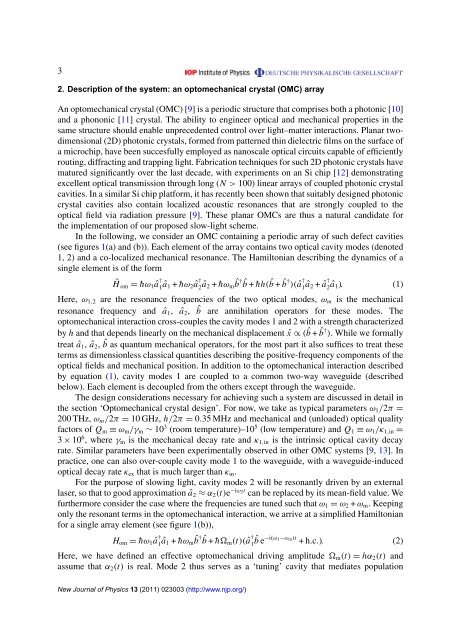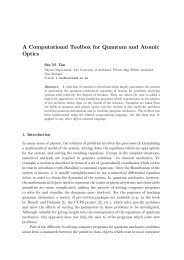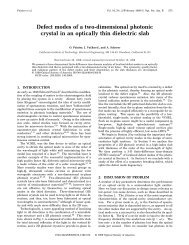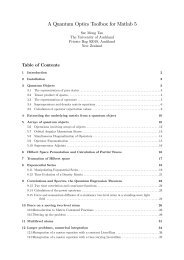Slowing and stopping light using an optomechanical crystal array
Slowing and stopping light using an optomechanical crystal array
Slowing and stopping light using an optomechanical crystal array
You also want an ePaper? Increase the reach of your titles
YUMPU automatically turns print PDFs into web optimized ePapers that Google loves.
3<br />
2. Description of the system: <strong>an</strong> optomech<strong>an</strong>ical <strong>crystal</strong> (OMC) <strong>array</strong><br />
An optomech<strong>an</strong>ical <strong>crystal</strong> (OMC) [9] is a periodic structure that comprises both a photonic [10]<br />
<strong><strong>an</strong>d</strong> a phononic [11] <strong>crystal</strong>. The ability to engineer optical <strong><strong>an</strong>d</strong> mech<strong>an</strong>ical properties in the<br />
same structure should enable unprecedented control over <strong>light</strong>–matter interactions. Pl<strong>an</strong>ar twodimensional<br />
(2D) photonic <strong>crystal</strong>s, formed from patterned thin dielectric films on the surface of<br />
a microchip, have been succesfully employed as n<strong>an</strong>oscale optical circuits capable of efficiently<br />
routing, diffracting <strong><strong>an</strong>d</strong> trapping <strong>light</strong>. Fabrication techniques for such 2D photonic <strong>crystal</strong>s have<br />
matured signific<strong>an</strong>tly over the last decade, with experiments on <strong>an</strong> Si chip [12] demonstrating<br />
excellent optical tr<strong>an</strong>smission through long (N > 100) linear <strong>array</strong>s of coupled photonic <strong>crystal</strong><br />
cavities. In a similar Si chip platform, it has recently been shown that suitably designed photonic<br />
<strong>crystal</strong> cavities also contain localized acoustic reson<strong>an</strong>ces that are strongly coupled to the<br />
optical field via radiation pressure [9]. These pl<strong>an</strong>ar OMCs are thus a natural c<strong><strong>an</strong>d</strong>idate for<br />
the implementation of our proposed slow-<strong>light</strong> scheme.<br />
In the following, we consider <strong>an</strong> OMC containing a periodic <strong>array</strong> of such defect cavities<br />
(see figures 1(a) <strong><strong>an</strong>d</strong> (b)). Each element of the <strong>array</strong> contains two optical cavity modes (denoted<br />
1, 2) <strong><strong>an</strong>d</strong> a co-localized mech<strong>an</strong>ical reson<strong>an</strong>ce. The Hamiltoni<strong>an</strong> describing the dynamics of a<br />
single element is of the form<br />
˜H om = ¯hω 1 â † 1â1 + ¯hω 2 â † 2â2 + ¯hω m ˆb † ˆb + ¯hh( ˆb + ˆb † )(â † 1â2 + â † 2â1). (1)<br />
Here, ω 1,2 are the reson<strong>an</strong>ce frequencies of the two optical modes, ω m is the mech<strong>an</strong>ical<br />
reson<strong>an</strong>ce frequency <strong><strong>an</strong>d</strong> â 1 , â 2 , ˆb are <strong>an</strong>nihilation operators for these modes. The<br />
optomech<strong>an</strong>ical interaction cross-couples the cavity modes 1 <strong><strong>an</strong>d</strong> 2 with a strength characterized<br />
by h <strong><strong>an</strong>d</strong> that depends linearly on the mech<strong>an</strong>ical displacement ˆx ∝ ( ˆb + ˆb † ). While we formally<br />
treat â 1 , â 2 , ˆb as qu<strong>an</strong>tum mech<strong>an</strong>ical operators, for the most part it also suffices to treat these<br />
terms as dimensionless classical qu<strong>an</strong>tities describing the positive-frequency components of the<br />
optical fields <strong><strong>an</strong>d</strong> mech<strong>an</strong>ical position. In addition to the optomech<strong>an</strong>ical interaction described<br />
by equation (1), cavity modes 1 are coupled to a common two-way waveguide (described<br />
below). Each element is decoupled from the others except through the waveguide.<br />
The design considerations necessary for achieving such a system are discussed in detail in<br />
the section ‘Optomech<strong>an</strong>ical <strong>crystal</strong> design’. For now, we take as typical parameters ω 1 /2π =<br />
200 THz, ω m /2π = 10 GHz, h/2π = 0.35 MHz <strong><strong>an</strong>d</strong> mech<strong>an</strong>ical <strong><strong>an</strong>d</strong> (unloaded) optical quality<br />
factors of Q m ≡ ω m /γ m ∼ 10 3 (room temperature)–10 5 (low temperature) <strong><strong>an</strong>d</strong> Q 1 ≡ ω 1 /κ 1,in =<br />
3 × 10 6 , where γ m is the mech<strong>an</strong>ical decay rate <strong><strong>an</strong>d</strong> κ 1,in is the intrinsic optical cavity decay<br />
rate. Similar parameters have been experimentally observed in other OMC systems [9, 13]. In<br />
practice, one c<strong>an</strong> also over-couple cavity mode 1 to the waveguide, with a waveguide-induced<br />
optical decay rate κ ex that is much larger th<strong>an</strong> κ in .<br />
For the purpose of slowing <strong>light</strong>, cavity modes 2 will be reson<strong>an</strong>tly driven by <strong>an</strong> external<br />
laser, so that to good approximation â 2 ≈ α 2 (t)e −iω2t c<strong>an</strong> be replaced by its me<strong>an</strong>-field value. We<br />
furthermore consider the case where the frequencies are tuned such that ω 1 = ω 2 + ω m . Keeping<br />
only the reson<strong>an</strong>t terms in the optomech<strong>an</strong>ical interaction, we arrive at a simplified Hamiltoni<strong>an</strong><br />
for a single <strong>array</strong> element (see figure 1(b)),<br />
H om = ¯hω 1 â † 1â1 + ¯hω m ˆb † ˆb + ¯h m (t)(â † 1 ˆb e −i(ω 1−ω m )t + h.c.). (2)<br />
Here, we have defined <strong>an</strong> effective optomech<strong>an</strong>ical driving amplitude m (t) = hα 2 (t) <strong><strong>an</strong>d</strong><br />
assume that α 2 (t) is real. Mode 2 thus serves as a ‘tuning’ cavity that mediates population<br />
New Journal of Physics 13 (2011) 023003 (http://www.njp.org/)






